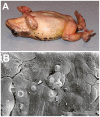Surveillance for emerging biodiversity diseases of wildlife
- PMID: 24875394
- PMCID: PMC4038591
- DOI: 10.1371/journal.ppat.1004015
Surveillance for emerging biodiversity diseases of wildlife
Conflict of interest statement
The authors have declared that no competing interests exist.
Figures

References
-
- Vrbova L, Stephen C, Kasman N, Boehnke R, Doyle-Waters M, et al. (2010) Systematic review of surveillance systems for emerging zoonoses. Transbound Emerg Dis 57: 154–161. - PubMed
-
- Foley J, Clifford D, Castle K, Cryan P, Ostfeld RS (2011) Investigating and managing the rapid emergence of white-nose syndrome, a novel, fatal, infectious disease of hibernating bats. Conserv Biol 25: 223–231. - PubMed
-
- Skerratt LF, Berger L, Speare R, Cashins S, McDonald KR, et al. (2007) Spread of chytridiomycosis has caused the rapid global decline and extinction of frogs. Ecohealth 4: 125–134.
-
- Carmichael C (2012) Coordinating an effective response to wildlife diseases. Wildl Soc Bull 36: 204–206.
-
- Kuiken T, Ryser-Degiorgis M-P, Gavier-Widen D, Gortazar C (2011) Establishing a European network for wildlife health surveillance. Rev Sci Tech 30: 755–761. - PubMed
Publication types
MeSH terms
LinkOut - more resources
Full Text Sources
Other Literature Sources
Medical

